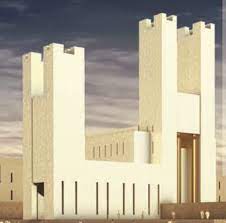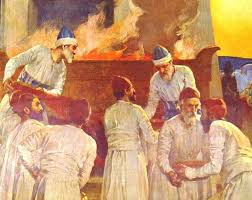My Chosen People Will Inherit My Mountains
Isaiah 65: 9
My chosen people will inherit My mountains DIG: What four covenants that are the basis of Isra’el’s final restoration? What geographical and topographical changes will take place in the Land during the Messianic Kingdom? How will the priesthood and sacrifices change? What twelve tribes will be given land?
REFLECT: Since the LORD is faithful in His promises to Isra’el, what does that say about His promises to you? What aspects of the Kingdom described here do you see yourself participating in? Why? How?
Once a Jew is resurrected, whether the righteous of the TaNaKh before the cross or a New Covenant believer after the cross, and the Messianic Kingdom begins, he or she will be the center of Gentile attention (Isaiah 14:1-2). The nation of Isra’el will continue to be God’s chosen people (Isaiah 65:9), and the apple of His eye (Deuteronomy 32:10). This is a major theme and high point in the prophets of the Hebrew Scriptures (see my commentary on Isaiah, to see link click Je – The Restoration of the Wife of the LORD). To spiritualize or allegorize away such a vast amount of the Bible is to confuse the whole discipline of interpretation. There is no reason to spiritualize any of these prophecies any more than there is reason to spiritualize the prophecies concerning the First Coming of Christ, such as the virgin birth, His birth in Bethlehem, His death or His physical resurrection.438
Dear Holy and wise Heavenly Father, You are so wonderful! Before You will rule during the Messianic Kingdom, You were willing to take on human form. May we also have this same attitude, being willing to love You so much that we will live for You in all we do and think. Have this attitude in yourselves, which also was in Messiah Yeshua, Who, though existing in the form of God, did not consider being equal to God a thing to be grasped. But He emptied Himself – taking on the form of a slave, becoming the likeness of men and being found in appearance as a man. He humbled Himself – becoming obedient to the point of death, even death on a cross. For this reason, God highly exalted Him and gave Him the name that is above every name, that at the name of Yeshua every knee should bow, in heaven and on the earth and under the earth, and every tongue profess that Yeshua the Messiah is Lord – to the glory of God the Father (Philippians 2:5-11). You are Awesome! In the holy name of Yeshua and the power of His resurrection. Amen.
Due to the considerable amount of revelation on Isra’el in the Messianic Kingdom, this section will be divided into eight paragraphs: (1) The four facets of Isra’el’s final restoration, (2) other characteristics of Isra’el’s final restoration, (3) the Millennial Mountain of the Lord’s House, (4) the Millennial Temple, (5) the messianic Priesthood and system of sacrifice, (6) the Millennial River, (7) Millennial Isra’el and (8) Millennial Jerusalem.
(1) There are four components of Isra’el’s final restoration, and each is based on a specific covenant. Each covenant is developed more extensively later in the Scriptures. First, is the regeneration of Isra’el, which is based on the New Covenant (Jeremiah 31:31-34). The fact that Isra’el was to undergo a national regeneration is not confined to the words of the New Covenant alone. There are many other scriptures to support it (Isaiah 29:22-24, 30:18-22, 44:1-5, 45:17; Jeremiah 50:19-20; Ezeki’el 11:19-20, 36:25-27; Hosea 1:10-11, 14:4-8; Joel 2:28-32; Micah 7:18-20; Zephaniah 3:9-13 and Romans 11:25-27).
The second component is the regathering of Isra’el, which is based on the Land Covenant (Deuteronomy 29:1 to 30:20). The regathering of Isra’el, following the regeneration, is another high point of prophetic revelation to be found in many of the prophets (Isaiah 11:10 to 12:6, 27:12-13, 43:5-7; Jeremiah 16:14-15, 23:3-8, 31:7-10; Ezeki’el 11:14-18, 36:24; Amos 9:14-15; Zephaniah 3:18-20; Zechariah 10:8-12 and Matthew 24:31).
The third component is the possession of the Land, which is based on the Abrahamic Covenant (Genesis 12:1-3). At the time that the Covenant was first made, Abram was merely told to go to a Land that ADONAI would show him. When he arrived in the Land, God again revealed Himself to Abram (Genesis 12:7), and promised the Land to him and his descendants forever (Genesis 13:14-17). Later, the exact boundaries were given (Genesis 15:12-21). This covenant was reconfirmed through Isaac (Genesis 26:2-5), and Jacob (Genesis 28:13-15). The possession and productivity of the Land was developed further by both Torah and the prophets (Leviticus 26:40-45; Deuteronomy 30:5; Isaiah 27:12-13, 30:23-26, 35:1-2, 65:21-24; Jeremiah 31:1-6 and 11-14; Ezeki’el 20:42-44, 28:25-26, 34:25-31, 36:8-15, and 28-38; Joel 2:18-27; Amos 9:13). So for the first time in Isra’el’s history, she will possess all of the Promised Land while the Land itself will greatly increase in its productivity and be well watered, all on the basis of the Abrahamic Covenant.
The fourth component is the reestablishment of the throne of king David, which is based on the Davidic Covenant (Second Samuel 7:11b-16; First Chronicles 17:10b-14). The Messiah holds three offices: prophet, priest and king. However, He does not function in all these offices simultaneously. Rather, the functioning of these three offices is to be carried out in a chronological sequence. During His first ministry on earth at His First Coming, Yeshua functioned in the office of a prophet. But this ceased at the time of His death. Since His death and resurrection, and until He returns, He is functioning in the office of a priest. This ministry will cease at the Second Coming. Jesus has never yet functioned in the office of a king. For Him to do so, there must be the reestablishment of the throne of David upon which He will sit to rule as King over Isra’el and King of the world (Psalm 89:3-4, 29, 34-37; Jeremiah 33:17-26; Amos 9:11-12 and Luke 1:32-33). This ministry will begin at the Second Coming. Therefore, the promises that God made to Isra’el have not been rendered null and void. Isra’el is yet to enjoy all the promises of the four unfulfilled unconditional covenants, each of which points respectively to the four components of Isra’el’s final restoration.439
(2) There are also other characteristics of Isra’el’s final restoration. There are three other points that deal with Isra’el’s final restoration that are not connected with any specific covenant. First, one of the major characteristics of the final restoration will be that Isra’el will be reunited as a nation, never to be divided into separate kingdoms again (Jeremiah 3:18; Ezeki’el 37:15-23). Secondly, she will become the center of Gentile attention (Isaiah 14:1-2, 49:22-23, 61:4-9; Micah 7:14-17; Zephaniah 3:20; Zechariah 8:23). At the time of the restoration, the Jews will no longer be treated with contempt. Instead, they will be treated with reverential respect, for they will be known as the ministers of God. Thirdly, she will be characterized by righteousness, holiness, peace, security, joy and gladness (Isaiah 32:16-20, 35:5-10, 55:12-13 and 61:10-11).
(3) The Millennial Mountain of ADONAI’s House. At the time of the Second Coming, Isra’el will experience some incredible geographical and topographical changes. One of the most striking changes will be the rise of a very high mountain that will become the highest mountain in the world. On top of this mountain will stand the millennial Jerusalem and Temple. There are several passages that describe this Millennial Mountain of the Temple, of ADONAI’s House (Isaiah 2:2-4). Later, Isaiah tells us that this high mountain will become the center of Jewish (Isaiah 27:13) and Gentile (Isaiah 56:6-8) worship. In fact, the Gentiles will bring the people of Isra’el there (Isaiah 66:20; Ezeki’el 17:22-24; Micah 4:1-2). Later, Ezeki’el prophesies how the holy mountain will be the center of Jewish worship in the Millennial Kingdom (Ezeki’el 20:40-41). And only in the closing chapters of his scroll does Ezeki’el fill us in on the details of what the Millennial Temple will be like (Ezeki’el 40:1-4, 45:1-8 and 48:8-20).

(4) The Millennial Temple. The LORD spoke through the prophet Ezeki’el when He said: I will make a covenant of peace with the nation of Isra’el; it will be an everlasting covenant. I will establish them and increase their numbers, and I will put My sanctuary among them forever (see my commentary on Exodus Fi – The Sanctuary in the Tabernacle). My dwelling place will be with them; I will be their God, and they will be My people. Then the nations of the world will know that I, ADONAI make Isra’el holy, when My sanctuary, or the Millennial Temple, is among them forever (Ezeki’el 37:26-28). Ezeki’el goes into much more detail about the Millennial Temple later in his scroll (Ezeki’el 40:5 to 43:27). It will be the center of Jewish and Gentile worship during the Millennium (to see a video of Ezeki’el’s Temple click here).

(5) The Messianic Priesthood and system of sacrifice. Ezeki’el 44:1 to 46:24 describes the various regulations concerning the millennial priesthood and its system of sacrifice. As there are similarities with the commandments of the Torah, there are also some obvious differences. Therefore, the millennial system of priesthood and sacrifice cannot be seen as merely a reestablishment of the Torah, which permanently ended with the death of Christ. During the Millennial Kingdom a brand new system will be established. It will contain some old commands and some new commands, and be instituted for an entirely different purpose (see my commentary on Isaiah Db – The Nine Missing Articles in the Messiah’s Coming Temple).

(6) The Millennial River. There will be a millennial river flowing from the millennial Temple (Joel 3:18; Ezeki’el 47:1-2). It will flow east from the Temple until it passes the eastern gate, then it will head south toward Jerusalem (Zechariah 14:8). There it will divide into two branches. The western branch will flow down the mountain and empty into the Mediterranean Sea (see my commentary on Isaiah – Ge Your Eyes Will See the King in His Beauty). The eastern branch will flow to the Dead Sea, which will change it dramatically, being teamed with life (Ezeki’el 47:8-10).
(7) Millennial Isra’el. For the first time in Isra’el’s history, the Jews will possess and settle in all of the Promised Land, or millennial Isra’el. It will be divided among the twelve tribes, but they will be divided differently than those described in the book of Joshua. The northern boundary will extend from the Mediterranean Sea, incorporating much of modern-day Lebanon and parts of modern Syria over to the Euphrates River. The eastern border will move south from the Euphrates River, including the Golan Heights and portions of Syria almost up to Damascus, and continue south to the Jordan River where it will extend to the Sea of Galilee. The border will then run along the Brook of Egypt, the modern Wadie-el-Arish, to the point where it reaches the Mediterranean Sea, that will serve as the western border. The tribes will run from north to south in the following order: Dan, Asher, Naphtali, Manasseh, Ephraim, Reuben. The mountain of ADONAI’s House will serve as a dividing line between the seven northern and five southern tribes. Then the five remaining southern tribes are described running from north to south in the following order: Benjamin, Simeon, Issachar, Zebulun and Gad.
(8) Millennial Jerusalem. While Ezeki’el closes the final section of his book with a short description of millennial Jerusalem, other inspired writers of the Hebrew Scriptures give us more detail. The Psalter tells us that the LORD will establish His beautiful City, where Zion will be glad and rejoice (Psalm 48:1-14). The City of God (Psalm 87:1-7) will be known for its strength and peace as a result of the reestablishment of the throne of David (Psalm 122:1-9, 147:2-20; Isaiah 66:10-14). It will be characterized by holiness, justice and righteousness (Isaiah 1:26-27, 33:20-24, 52:1-2; Jeremiah 31:38-40; Joel 3:17), because the Messiah will reign there (Isaiah 52:7-10; Micah 4:6-8; Zephaniah 3:14-17). Jerusalem will become the center of worldwide attention for the sheep Gentiles and their descendants (Isaiah 60:10-14; Jeremiah 3:17; Zechariah 8:20-22). The Gentile nations, who in the past afflicted the City of Jerusalem, will, at that time, bow in submission to its authority (Isaiah 62:1-12). Peace and joy will return to Jerusalem (Jeremiah 33:9-11), because ADONAI Himself has chosen to rebuild her and dwell there (Zechariah 1:14-17, 2:1-12, 8:1-8). At that time the City of Peace will finally live up to its name. The golden age of Jerusalem is yet to come (Zechariah 14:20-21).440



Leave A Comment